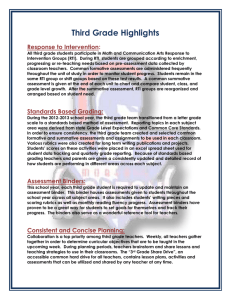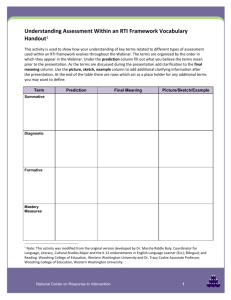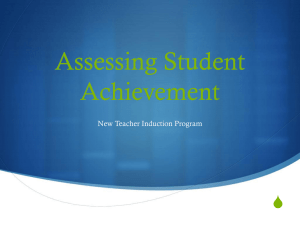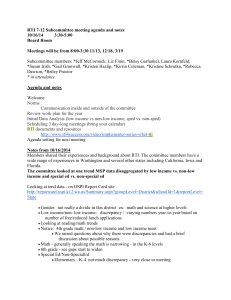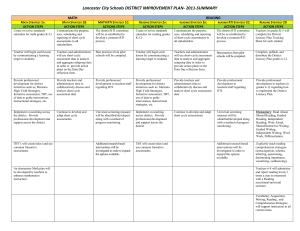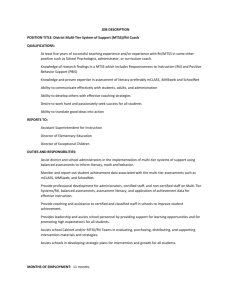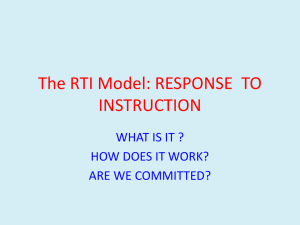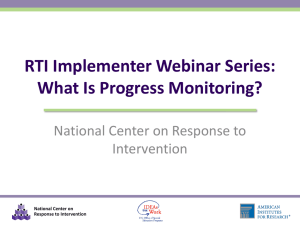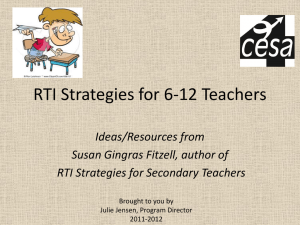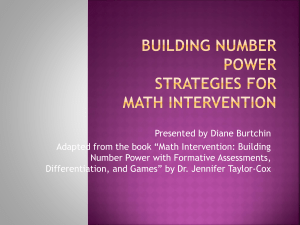Inquiry-Oriented Assessment
advertisement
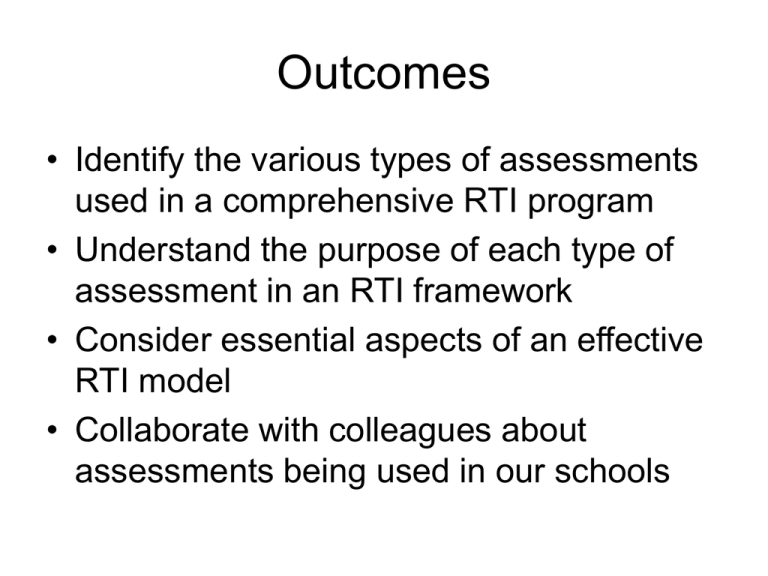
Outcomes • Identify the various types of assessments used in a comprehensive RTI program • Understand the purpose of each type of assessment in an RTI framework • Consider essential aspects of an effective RTI model • Collaborate with colleagues about assessments being used in our schools Agenda • • • • • • • Welcome and Introduction Types of Assessments Purpose of Each Assessment Explore Examples of Each Assessment RTI Assessment Audit Think, Pair, Share Activity Most Important Point (MIP) The Expanded Assessment Approach Screening/Benchmarking Summative Intervention/Instruction Formative Progress Monitoring Diagnostic Inquiry-Oriented Assessment Teacher knowledge and ability to identify and administer powerful assessment tools & techniques, and use the results to make informed instructional decisions. Inquiry-Oriented Assessment is viewed as a “springboard” to understanding student learning--not as static “facts.” Adapted from the International Reading Association: Karen Wixson, Shelia Valencia, and Carol Conner Types and Purposes of Assessments Type Purpose Frequency Scope Screening/ Benchmarking Monitor overall progress-Identify at-risk students 3-4 times a year Broad Diagnostic Identify focus of intervention Once a year or more (as needed) Specific strengths or needs Progress Monitoring (Formative) Inform ongoing instruction Ongoing Fine-tuned, aliened with curriculum Summative (Outcome) Identify level of performance Once a year Very Broad Examples of Screening Measures • http://www.rti4success.org/chart/screening Tools/ScreeningToolsChart.pdf • AIMSWeb • DIBELS • AutoSkill Examples of Diagnostic Measures • http://www.k12.wa.us/RTI/AssessmentGui de/FormativeDiagnosticAssessmentGuide. pdf • STAR Literacy Renaissance Learning, INC • Developmental Reading Assessment, Second Edition (DRA 2) • Woodcock-Johnson III Diagnostic Reading Battery (WJ III DRB) Examples of Progress Monitoring (Formative) • Common tools include AIMSWeb and DIBELS • Implement during instruction to monitor and adjust • Other examples include: running records, think alouds, samples of student work, logs, anecdotal records, etc. • Frequency and focus on assessment will depend on the student’s needs Examples of Summative (Outcome) Assessments • • • • • NYS 3-8 and Regents Exams Entrance or Exit Exams End of Course/Year Exams Gates-MacGinitie Reading Test 4th Edition Iowa Tests of Basic Skills (ITBS) RTI Assessment Audit 1. 2. 3. 4. 5. Identifies the different types of assessments used in the area of literacy Clarifies the purpose (screening, progress monitoring, diagnostic, and outcome) of each assessment tool Identifies the construct being assessed (e.g.. concepts of print, comprehension, fluency, etc..), Identifies training needs of staff members relative to the administration and interpretation of targeted assessments; Provides an opportunity for a school to identify redundancies or gaps in the assessment process. A Modified Think, Pair, Share Activity • Individually please record one assessment per post-it. You will have approximately 5 minutes to complete this activity. • Pair with an elbow partner and share your post-its. You will have approximately 5 minutes to share with your elbow partner. Post-It Activity • Please post your assessment being used on the appropriate chart paper. We have used the following categories; Elementary (K-5), Middle School (6-8), or High School (9-12) • The assessment types are provided on the chart paper Gallery Walk • Please take a few minutes to visit each piece of chart paper for different ideas in order to make your district assessment plan complete at each grade level Types of Data Demographics School Processes Perceptions Student Learning Victoria Bernhardt Other Considerations • • • • • School Readiness Accessibility of Student Data Assessment Literacy of staff members Professional Development Fidelity of Implementation -Intervention/Instruction Delivered as designed -Screening and Progress Monitoring standardized -Researched based intervention/instruction -Administrators Role • Triangulation, Triangulation, Triangulation • Be Patient M I P As I reflect on this information, the Most Important Point for me is……. RTI TAC Website • http://www.nysrti.org/page/pilot-schools/ • RTI Action Plans Our Contact Information Lori DeForest Supervisor of Data Analysis Services Email: ldeforest@cnyric.org Phone Number: (315) 433-2247 Terry Ward District Data Coordinator Email: tward@cnyric.org Phone Number: (315) 433-2263
